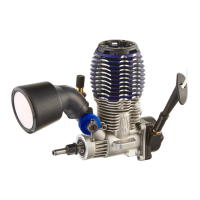
Do you have a question about the Traxxas TRX 2.5R and is the answer not in the manual?
| Displacement | 0.15 cu in (2.5 cc) |
|---|---|
| Cooling System | Air-cooled |
| Engine Type | 2-Stroke |
| Fuel Type | Nitro |
| Starting System | Pull-start |
| Glow Plug | Standard glow plug |
| Recommended Fuel | 20% Nitro |
Identifies warnings, hints, and cross-references used throughout the manual.
Provides contact information for technical support and service options.
Explains the importance of using Traxxas Top Fuel for performance and engine life.
Discusses the use of other fuel brands and potential long-term consequences.
Provides instructions on safe storage and handling of RC fuel.
Details the step-by-step process for cleaning and oiling the air filter element.
Provides factory settings for carburetor needles if adjustments have been altered.
Explains the role of high-speed and low-speed needles in controlling fuel mixture.
Discusses finding the optimal balance for power and engine life via fuel mixture.
Outlines the procedure for breaking in the engine for optimal performance and sealing.
Lists key considerations and precautions for the engine break-in process.
Provides initial steps and procedures for starting the engine for the first time.
Offers advice for breaking in the engine in cold weather conditions.
Explains how fuel mixture affects engine performance and tuning.
Details how to adjust the high-speed needle for optimal performance.
Describes how to adjust the low-speed needle using the pinch test.
Explains how to set the idle speed for reliable operation.
Guides on adjusting carburetor needles based on weather conditions.
Explains how to use temperature gauges to aid in engine tuning.
Addresses common issues when the engine fails to start.
Discusses symptoms of a worn engine and factors affecting its lifespan.
Troubleshoots issues where the engine cannot be turned over.
Addresses sluggishness and starting issues during the initial break-in.
Explains causes of sluggish engine performance and how to address them.
Provides steps to clear excess fuel from a flooded engine.
Offers guidance on how to free a piston stuck at the top dead center.
Details essential maintenance tasks to perform after each hour of operation.
Outlines checks and inspections needed after every use.
Explains the critical after-run maintenance for engine protection and longevity.
Covers periodic replacement of engine parts like piston/sleeve and connecting rod.
Describes cleaning and drying the crankcase and bearings.
Details inspection of crankshaft, bearings, and O-rings for damage.
Guides on reinserting and securing the carburetor after cleaning.
Explains how to assemble the piston, connecting rod, and wrist pin.
Details installing the sleeve, head gasket, and cooling head.
Guides on installing the backplate and starter shaft.
Covers installing the flywheel, clutch shoes, and clutch bell.
Details installing the roller clutch and starter system.
Covers reattaching the exhaust header and pipe assembly.